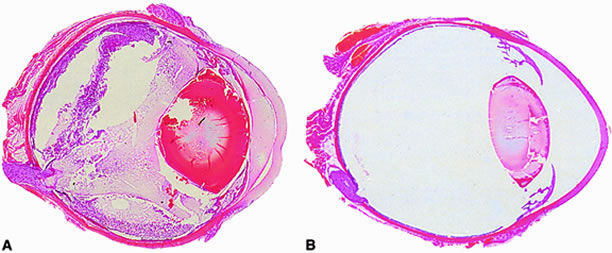

|
| Fig. 3. Whole-eye histology of motile (A) and nonmotile (B) experimental Bacillus endophthalmitis. Approximately 100 colony forming units (CFU) of a motile endophthalmitis isolate of Bacillus thuringiensis or a nonmotile isogenic mutant of B. thuringiensis was injected intravitreally into rabbit eyes. Eyes were harvested for histologic analysis at 18 hours. By 18 hours, in eyes infected with motile B. thuringiensis, retinal dissolution and detachment, severe inflammation, and corneal edema were apparent. The posterior and anterior segments were engorged with inflammatory cells and fibrin. Eyes infected with the nonmotile mutant of B. thuringiensis appeared normal throughout 18 hours postinfection. (Data compiled from Callegan MC, Cochran DC, Kane ST et al. The contribution of bacterial motility to Bacillus endophthalmitis pathogenesis. Association for Research in Vision and Ophthalmology Annual Meeting, 2001, Abstract 1382) |